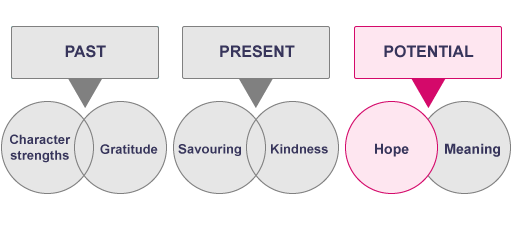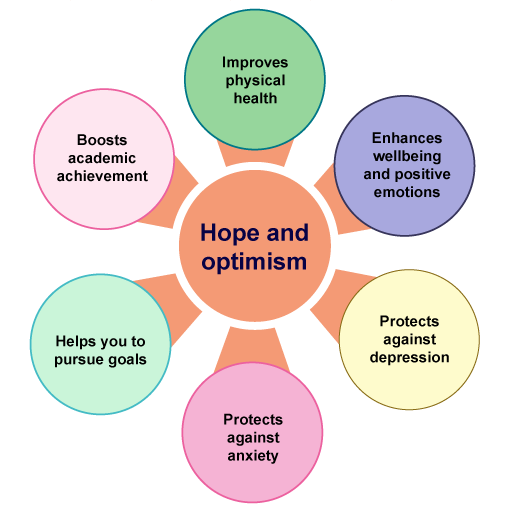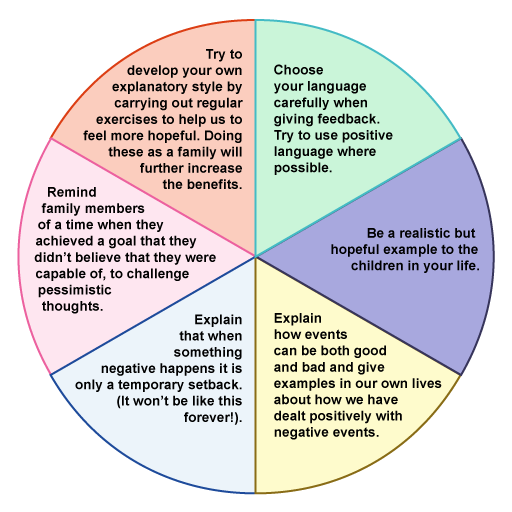Use 'Print preview' to check the number of pages and printer settings.
Print functionality varies between browsers.
Printable page generated Saturday, 22 November 2025, 3:34 PM
Unit 6: Hope and optimism
The fifth of six themes
Throughout this course you are introduced to some of the ways you can boost your happiness and wellbeing, and that of your children, using six key themes that have been shown to improve wellbeing through the way we think about the past, present and future potential.
The fifth of these six themes is illustrated in the diagram below.
For this fifth theme, you are shown some practical activities that you can try at home. The benefits of these have all been supported scientifically and can be attempted by yourself during the course. They can also be adapted to work with children of all ages within the home. Being a good role model to our children is also a great way to help enhance their wellbeing.
 Mindful minute
Mindful minute
To start each unit, it is helpful to try to switch off from what has been happening in your day and greet your learning from a place of relaxation. The following exercise can be a way of doing this, so please feel free to try this. Alternatively, you may have your own way of switching off from the distractions of your day, like making a hot drink or putting on some calming music.
Sit in a comfortable position with your hands resting on your lap. Try to keep your back, neck and head straight and place both of your feet flat on the floor.
Bring your attention to your breath and consciously try to relax your shoulders. Imagine that the muscles in your shoulders are melting into your body and breathe deeply into your belly so that you can feel it expanding.
Press the button below which will set a timer for 1 minute. Close your eyes and continue to focus on your breathing and relaxing your shoulders. It is normal for your mind to wonder, and when this happens try to gently bring it back to your breathing and relaxing.
After a minute you will hear a buzzer. Open your eyes and continue with the course.
6.1 What is hope and optimism and how can it help you and your family?
We have hope when we expect or anticipate that we will attain what we desire.
If we have a tendency to look to the future with such a hopeful or positive outlook, then we are likely to be described as being optimistic. Optimists have a built-in attitude to be hopeful all the time and consider the possibilities of good things happening in life.
This tendency to take a hopeful approach to the future is summed up by the popular metaphor as seeing a ‘glass as half full’ rather than a ‘glass half empty.
 The benefits of having a hopeful and optimistic attitude
The benefits of having a hopeful and optimistic attitude
In this video Michelle invites you to consider the benefits of having a hopeful and optimistic attitude and to learn about how and if this can be cultivated and if it is possible to ‘learn’ optimism.

Transcript
Positive psychology suggests that it is possible to develop your capacity to take an optimistic outlook on life. It defines optimism as a set of beliefs and qualities that help individuals to focus on the positive aspects of life rather than the negative ones, showing resilience and personal strength.
Embracing optimism doesn’t make us immune to worries and stress, rather it teaches us to see the bigger picture regarding what is going wrong and still be hopeful that it can be turned right. Being able to approach difficulties, such as enduring lockdowns during the pandemic, with an optimistic outlook can help us to be more resilient and bounce back more quickly.
 Hope and optimism
Hope and optimism
Which of the quotes above do you most relate to and why?
Note your thoughts in the text box below.
The diagram below highlights some of the benefits of hope and optimism.
6.2 Realistic hope and optimism
It is clear that there are benefits to cultivating hope and optimism.
However, it is important to consider that sometimes people can be overly optimistic in a way that is in contrast to the reality around them. This is often known as ‘blind optimism’ or having ‘false hope’ and could lead to people making unwise decisions.
Positive psychologists would encourage people to aim for realistic hope and optimism, appreciating any risks in a situation as well as actively looking for any positive opportunities to improve the potential outcome.
 How optimistic or hopeful are you?
How optimistic or hopeful are you?
Here is a short questionnaire that you can complete to help you to work out how optimistic/hopeful you are. There are no right or wrong answers, so try not to think too hard about your responses:
Follow the scoring information given at the bottom of the questionnaire to discover how optimistic/hopeful you are.
You can download this writable PDF version of the questionnaire if you prefer to save it to your device and/or print it out.
If you find that you feel that you are less optimistic in life that is perfectly normal, and the world is full of optimists and pessimists. Often this will have been of benefit to you and perhaps helped you to cope, to be prepared, and to not feel surprised when things in life go wrong.
In the long term, however, you may feel that it would be of benefit to explore some exercises from positive psychology as research has found that hope and optimism are not static attributes and that you can learn ways to improve them.
 Are you optimistic or pessimistic?
Are you optimistic or pessimistic?
Where would you place yourself on this line? Use the interactive slider to locate where you think you are.
A downloadable PDF version of the interactive is available for accessibility or if the interactive doesn't play in your browser.
It can be helpful to recognise how naturally optimistic you are in order to consider how you have an effect on those around you. We call our thoughts around how optimistic we are, our explanatory style.
The graphics below gives us two examples of how the explanatory styles of an optimist or pessimist might react to a negative event, in this example the outcome of a job interview.
Look at the first diagram below, which demonstrates how the explanatory styles of an optimist and a pessimist react in a different way to an unsuccessful job interview
Now look below at how the explanatory styles of an optimist and pessimist react to a successful job interview.
6.3 Hope and optimism activities for you and your family
Now that you have developed a clearer understanding of the benefits of developing a more optimistic outlook, we explore some ideas that you can use both on your own and with your family, that have been shown to train your mind to become more hopeful.
It has been suggested by Seligman (2002) that we learn our explanatory styles as children, by the adults that are around us. We tend to imitate the voices that we hear the most, like our parents, caregivers, teachers, etc. As a child, when we hear an optimistic voice, we internalise that message and believe it to be true, and so this makes the child view the world in a more optimistic way.
Likewise, this idea also works the opposite way too. For example, if a teacher tells a child that they are hopeless at reading, the child might grow up believing this and may refuse to read books as an adult, as they feel it would be hopeless to do so.
Assuming the possible effects of praise/criticism, it is important to consider how our explanatory style might affect the people around us in our home and family.
We can do this in the following ways that are demonstrated in the diagram below.
 Activities to foster hope and optimism
Activities to foster hope and optimism
Here are some additional activities that can help to foster hope and optimism in your family.
Spend more time with optimistic and positive people
Think of people around you who tend to look on the bright side of life. Plan to spend more time with them as optimistic attitudes can often be contagious. Connecting with others and focusing on more positive outcomes to problems may help you to avoid more negative ways of thinking.
Gardening
Buy some seeds, sunflower seeds are a good choice, and plant them in pots with your family. Water them and watch them grow. Talk together about how, with patience and care, beautiful things can grow from very little.
Remember happy times
It can be easy to feel, especially for children, that a difficult time will never end. Remind yourself and your family of times when you were resilient and positive, and the outcome was good. Think about how this made you feel at the time and consider whether you will still be worrying about this problem next year. Share hopeful stories with each other.
Look for the silver lining when possible
When dealing with challenging times, it can be helpful to try to gain perspective by looking for any positives in the situation. This can help you to be more rational and use less ‘black and white’ thinking, recognising that there may be something positive to take from the situation
6.4 Will and way
The old saying goes, ‘Where there’s a will, there’s a way.’
The psychologist Richard Snyder (1991) created a model of hope based on this saying. The Will is the thing you’d like to achieve, and The Way is how you will achieve it.
 The will and the way
The will and the way
Think about a task or goal that you would like to achieve in the near future. Consider the following questions and make notes of your thoughts in the text boxes below.
| What would you like to achieve today? | |
| How do you think you could achieve this? | |
| What problems might you come up against? | |
| What could you do to help you stay motivated? |
6.5 Summary
Now that you have attempted some activities, you might like to complete the hope questionnaire again to see if you have noticed any changes.
Please note that it may take a sustained effort over time to see any dramatic changes.
Follow the scoring information given at the bottom of the questionnaire to discover how optimistic/hopeful you are.
You can download this writable PDF version of the questionnaire if you prefer to save it to your device and/or print it out.
In the next and final unit, you explore how meaning and purpose can help you and your family to build a more positive future.
 Further resources
Further resources
Lopez, S. J. (2014) Making Hope Happen: Create the Future You Want for Yourself and Others. New York: Simon & Schuster |
Seligman, M. (1991). Learned Optimism: How to change your mind and your life. New York: Vintage Books. |
Now go to Unit 7: Meaning and purpose, where you explore the last of our six principles.
References
Ciarrochi, J., Parker, P., Kashdan, T.B., Heaven, P.C. & Barkus, E. (2015) 'Hope and emotional well-being: A six-year study to distinguish antecedents, correlates, and consequences', The Journal of Positive Psychology, 10(6), pp.520-532.
Conti, R. (2000). 'College goals: Do self-determined and carefully considered goals predict intrinsic motivation, academic performance, and adjustment during the first semester?', Social Psychology of Education, 4(2), 189-211.
Erez, A. & Isen, A. M. (2002) 'The influence of positive affect on the components of expectancy motivation', Journal of Applied Psychology, 87(6), 1055–1067. https://doi.org/10.1037/0021-9010.87.6.1055.
Forgeard, M.J.C. & Seligman, M.E.P. (2012) 'Seeing the glass half full: A review of the causes and consequences of optimism', Pratiques Psychologiques, 18(2), pp.107-120.
Michael, S.T. (2000) 'Hope conquers fear: Overcoming anxiety and panic attacks', Handbook of Hope, pp. 301-319, Academic Press.
Schiavon, C.C., Marchetti, E., Gurgel, L.G., Busnello, F.M. & Reppold, C.T. (2017) 'Optimism and hope in chronic disease: a systematic review', Frontiers in Psychology, 7, p.202.
Snyder, C. R., Shorey, H. S., Cheavens, J., Pulvers, K. M., Adams, V. H., & Wiklund, C. (2002) 'Hope and Academic Success in College', Journal of Educational Psychology, 94, 820-826.https://doi.org/10.1037/0022-0663.94.4.820.
Snyder, C.R., Harris, C., Anderson, J.R., Holleran, S.A., Irving, L.M., Sigmon, S.T., Yoshinobu, L., Gibb, J., Langelle, C. & Harney, P. (1991) The will and the ways: development and validation of an individual-differences measure of hope', Journal of Personality and Social Psychology, 60(4), p.570.
Snyder, C.R., Sympson, S. C., Ybasco, F. C., Borders, T. F., Babyak, M. A., & Higgins, R. L. (1996) 'Development and validation of the State Hope Scale', Journal of Personality and Social Psychology, 70, 321−335.









